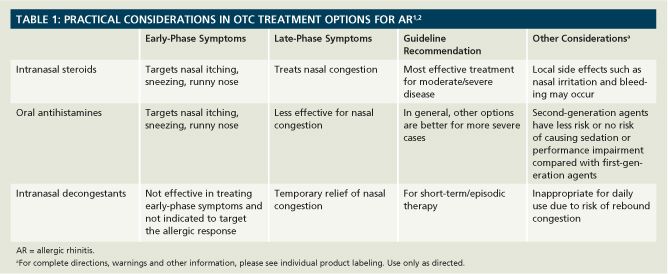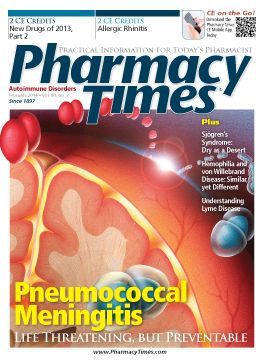Publication
Article
Pharmacy Times
Intranasal Steroids: A New OTC Pharmacologic Option for Controlling Allergic Rhinitis Symptoms
Author(s):
This article was sponsored by Chattem, Inc.
The symptoms associated with allergic rhinitis (AR) can substantially impact the quality of life for the 10% to 30% of adults and up to 40% of children in the United States who have the condition.1 Intranasal steroids (INSs) are an effective, well-tolerated treatment for AR. Current guidelines support the first-line use of INSs, stating that they are the most effective class of medications for treating AR symptoms, especially when used consistently.1,2 Despite these recommendations, INSs remain underutilized in AR.3 With the recent OTC availability of an INS, pharmacists should be prepared to help educate patients directly on their appropriate use.
Background
In 80% of cases, the onset of AR occurs before 20 years of age, although onset may occur at any time.1 AR is commonly classified as either seasonal allergic rhinitis (SAR) or perennial allergic rhinitis (PAR). SAR, commonly known as hay fever, is characterized by an immune response to an outdoor allergen (eg, pollen, weeds, grass) to which exposure is typically seasonal. Conversely, PAR generally occurs year-round due to indoor allergens (eg, dust mites, animal dander).1,4 Symptoms include rhinorrhea, sneezing, nasal itching, and congestion.1
The body’s immune response to allergens can be described in terms of an allergic cascade of early-phase and late-phase responses. Early-phase symptoms, which typically include rhinorrhea and sneezing, are caused by mast-cell—derived inflammatory mediators. This phase occurs within minutes of exposure to an allergen. The late-phase response, which is largely characterized by nasal congestion, occurs over the next several hours through the infiltration of inflammatory cells that leads to further release of inflammatory mediators and hypersensitivity of the nasal mucosa.1,5 Uncontrolled AR symptoms can negatively impact quality of life by causing fatigue, cognitive impairment, and sleep disturbances, and can worsen other respiratory-related conditions that frequently coexist with AR, such as asthma.1,2
OTC Treatment Options in AR
Current guidelines published by the American Academy of Allergy, Asthma & Immunology (AAAAI) and the American College of Allergy, Asthma & Immunology (ACAAI) recommend the selection of pharmacotherapy primarily based on patient age, allergen exposure pattern, and the frequency, severity, and spectrum of the symptoms. Several OTC options are available for the treatment of AR, including oral antihistamines and oral and intranasal decongestants. Oral antihistamines improve the early-phase symptoms—sneezing, itching, and rhinorrhea—but have less of an effect on nasal congestion once it is present.1,5 Second-generation antihistamines have less of a tendency to cause sedation and thus are preferred over first-generation antihistamines (Table 1).1,2 Oral and intranasal decongestants target the predominately late-phase symptom of nasal congestion. However, the use of oral decongestants has been associated with side effects such as insomnia, irritability, palpitations, and hypertension. Although intranasal decongestants have minimal side effects, the FDA recommends their use not exceed 3 days due to the risk of rebound congestion associated with prolonged use.1,6
The latest OTC option for the treatment of AR is an INS, Nasacort Allergy 24HR (triamcinolone acetonide), which is indicated for the treatment of seasonal and year-round nasal allergies. The OTC product is the same formulation and strength as the original prescription product Nasacort AQ.7 INSs, which act by decreasing the influx of inflammatory cells, effectively treat both early- and late-phase symptoms, and have minimal side effects.1,5,8
The Role of INSs in AR Management
AAAAI/ACAAI guidelines state that INSs are the most effective pharmacologic treatment for controlling the 4 main symptoms associated with AR—sneezing, runny nose, nasal itching, and nasal congestion. INSs are particularly useful in more severe cases. Monotherapy with an INS is more effective than treatment with an antihistamine alone or in combination with a leukotriene antagonist.1
Once administered, some symptoms may improve on the first day of use. It can take up to a week for most symptom relief. INSs are most effective when used on a more consistent basis.1 One of the advantages of using an intranasal medication is that it delivers high concentrations of the active ingredient locally, lessening or avoiding any systemic effects.2

Role of the Pharmacist
Many patients do not consult a physician for AR symptoms and may be unaware of their condition. Patients can benefit from having a pharmacist assist them in the selection of an OTC treatment when presenting with AR-associated symptoms. Questions regarding the type, duration, frequency, and severity of symptoms, potential triggers, exposure to common allergens, and the color of the nasal discharge help to distinguish between allergic and nonallergic symptoms. Certain symptoms, such as congestion that only occurs on 1 side of the nose, recurrent nosebleeds, or loss of smell may be signs of conditions other than AR. Also, nasal symptoms in the presence of a thick mucous, earache, or facial pain are unlikely to be AR (Table 2).2

If an INS is chosen as the most appropriate therapy for a patient, pharmacists should help patients understand the benefits of using a locally administered medication. Pharmacists can also help educate patients on proper administration of an INS. Minor nose bleeding and nasal discomfort or burning after administration are the most frequent side effects associated with their use. Patients should be instructed to administer each spray toward the outer side of the nose, away from the septum.1,9 It is also very important to counsel patients using INSs that they will achieve better results with consistent use, as this can lessen the impact of exposure to an allergen.1,8 As with any OTC product, patients should be instructed to follow the dosing recommendations on the label.
Conclusion
Guidelines state that INSs are the most effective medication for treating AR and that they are particularly useful in more severe cases. INSs work locally to treat both early- and late-phase symptoms and have few or no side effects. Pharmacists play a key role in the evidence-based management of SAR and PAR by helping patients make informed choices regarding OTC treatments, including the use of a newly available INS.
References
- Wallace DV, Dykewicz MS, Bernstein DI; Joint Task Force on Practice; American Academy of Allergy, Asthma & Immunology; American College of Allergy, Asthma & Immunology; Joint Council of Allergy, Asthma & Immunology. The diagnosis and management of rhinitis: an updated practice parameter. J Allergy Clin Immunol. 2008;122(2 suppl):S1-S84.
- Bousquet J, Khaltaev N, Cruz AA, et al. Allergic Rhinitis and its Impact on Asthma (ARIA) 2008 update. Allergy. 2008;(suppl 86):1-196.
- Gentile D, Bartholomew A, Valovirta E, Scadding G, Skoner D. Current and future directions in pediatric allergic rhinitis. J Allergy Clin Immunol. 2013;1(3):214-226.
- Austen K. Allergies, anaphylaxis, and systemic mastocytosis. In: Longo DL, Fauci AS, Kasper DL, Hauser SL, Jameson J, Loscalzo J, eds. Harrison’s Principles of Internal Medicine. New York: McGraw-Hill; 2012.
- Canonica GW, Compalati E. Minimal persistent inflammation in allergic rhinitis: implications for current treatment strategies. Clin Exp Immunol. 2009;158:260-271.
- US Food and Drug Administration. Final Monograph for OTC Nasal Decongestant Drug Products. Federal Register. 1994;59(162):43386-43412.
- Nasacort website. www.nasacort.com/hcp/. Accessed January 14, 2014.
- Sur DK, Scandale S. Treatment of allergic rhinitis. Am Fam Physician. 2010;81(12):1440-1446.
- Benninger M, Farrar JR, Blaiss M, et al. Evaluating approved medications to treat allergic rhinitis in the United States: an evidence-based review of efficacy for nasal symptoms by class. Ann Allergy Asthma Immunol. 2010;104(1):13-29.








